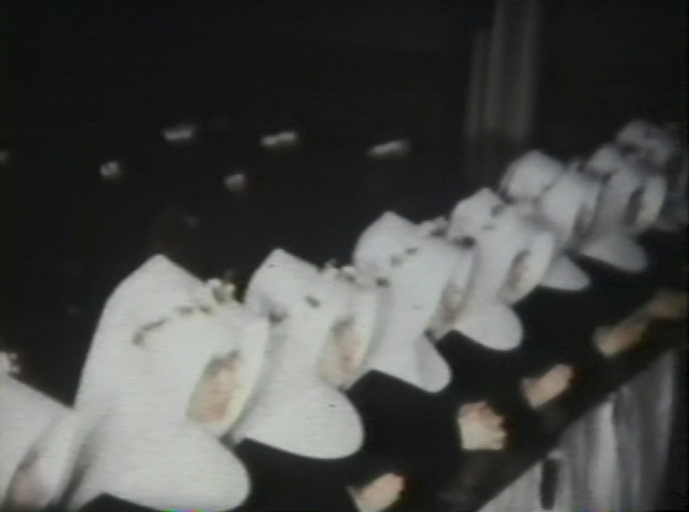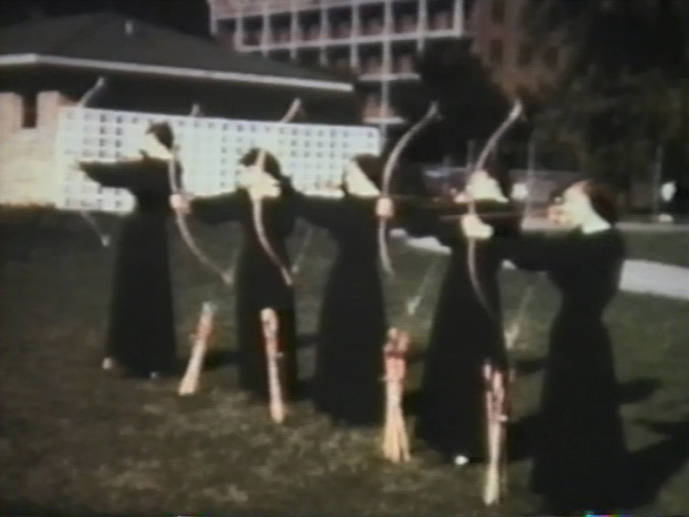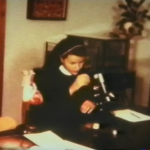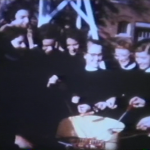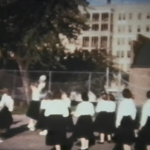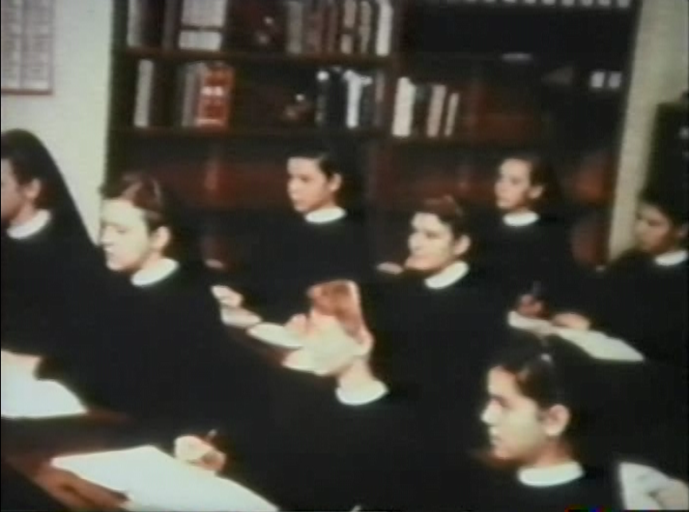Click here to print
Life in a Wisconsin Convent in 1958
posted June 19, 2017
With a grant from the National Film Preservation Foundation, the Congregation of Sisters of St. Agnes, in Wisconsin, will preserve a promotional film from the heyday of the recruitment of nuns to Catholic convents.
n
n
In the 1950s and 1960s, young women entered Catholic convents in numbers that have not recurred since. They joined in cohorts that were large enough that their process of formation could be as social as it was spiritual.
A 35-minute film made in 1958, Decision for Happiness, recorded some of the activities from that time at one convent in Wisconsin: prayer, instruction, and study, but also such activities as barbecues, volleyball, and even archery.
Those sorts of communal activities became less and less part of the daily lives of novices in the 1970s, and beyond, simply because fewer and fewer young women joined Catholic religious orders. Often, by the 1970s, a novice might be one of only a few to join a convent in any year, or indeed the only one, says Jennifer S. Lukomski, the director of archives at the Congregation of Sisters of St. Agnes, in Fond du Lac, Wisconsin.
After she began as the convent’s archivist last year, she came across three copies of Decision for Happiness, a portrait of a far different era in the convent’s history. Now, working with Colorlab, the Maryland specialist, she is leading a restoration and preservation of the film, using the best of the convent’s three copies. The work is possible thanks to a Basic Preservation Grant from the National Film Preservation Foundation, which this month made such awards to 36 institutions, to preserve 57 films.
n
“It really tells the story of the sisters, and how somebody becomes a sister,” says Lukomski.
Decision for Happiness was made to mark the centennial of the Congregation of Sisters of St. Agnes. In shows young novices preparing to take their vows, beginning with one young woman’s decision to join the sisterhood. It was designed as a recruitment film, to show in the area high schools from which the convent drew its novices.
Initially begun at St. Mary’s Springs Academy, a Fond du Lac high school that the sisters ran, the film became a community-wide project, with local actors, photographers, recording equipment from a local radio station, and an appearance from Milwaukee Archbishop Albert Meyer, who became a Cardinal in 1959.
The film shows and explains investiture and profession ceremonies — two of the steps towards full membership of an order — along with the instruction and training that sisters received for nursing and education.
The Congregation of Sisters of St. Agnes continues its long history, still, but preservation of Decision for Happiness is all the more significant given that it was made shortly before a steep decline in the recruitment of novices to Catholic convents. The start of the decline is often dated to – and ascribed to – the Second Vatican Council (“Vatican II”) which Pope John XXIII announced in 1959 and convened between 1962 and 1965. It ushered in major changes in Catholic practice and organization. From a high of 181,421 in 1966, the number of nuns in the United States has declined to around 47,000 today.
Lukomski has found a variety of films at the convent. Some were silent shorts – home movies from the convent – but Decision for Happiness was more ambitious. For a promotional film, it benefitted from a chance personal connection. One of the alumna of the nuns’ Fond du Lac high school happened to be married to Larry Heath, a Hollywood producer and editor. His credits include The George Burns and Gracie Allen Show and Gilligan’s Island. In making Decision for Happiness, he was able to secure technical services from MGM, RCA, and Pathé Studios.
{Click on an image to expand}
Those production values are not ideally preserved in the three copies of the film Jennifer Lukomski found at the convent, she says: “There are some bad splices; there might even be some missing segments. This was a well-used film, so our prints aren’t in the best condition.”
Decision for Happiness was screened intensively as a recruitment film, but only for a few years, until the mid-1960s. At some point, the three copies made their way back to the convent. By that time, membership of the Congregation, which had peaked in in the 1950s and early 1960s, had begun to fall away.
With the award, which is of $8,000, Lukomski will oversee repair of an original reversal print of the film, and the making of a new master print and a digital copy which Lukomski will place on the congregation’s website.
The film offers an opportunity for older members of the order to reminisce, and younger ones to see what the order was like before their membership, she says. Some of the longer-serving members of the congregation remember the film from those years, and some were even involved in the filming, she says: “Most of them had already joined the convent, when they saw it, when they were in their candidature, which is the first step.”
When the work is complete, in about a year, she will convene a gathering of members and supporters of the order, where nuns who were at the convent when the film was made, or even, in a few cases, appeared in it, can talk about those times — “so they can relive their memories.”
n
The project has generated considerable interest in the Sisters of St. Agnes community, she says. “It’s such a great window on what life was like back in the ’50s. You think about how things have changed over the years. There used to be large groups of sisters – they call them profession classes — every year, and then you get into the 70s and 80s, and you might only get one or two people at a time. So the process of religious formation changed because of that. Those newer sisters didn’t have those experiences that you see in the film.”
— Peter Monaghan
Printed from Moving Image Archive News: http://www.movingimagearchivenews.org
URL to article: http://www.movingimagearchivenews.org/life-in-a-wisconsin-convent-in-1958/
Click here to print
